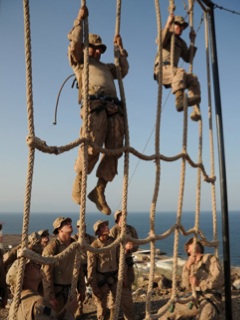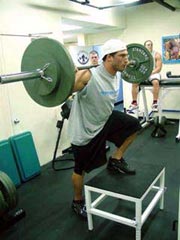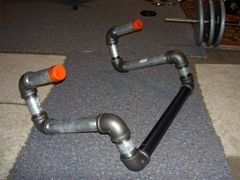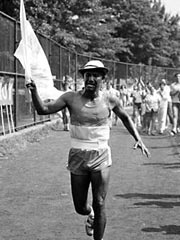Interesting idea.
Although I'd usually like something a little heavier, the 'wearable weight' approach would be ideal for several things. To give you an idea of what I mean by 'wearable weight', a bit of video :
Interesting idea.
Although I'd usually like something a little heavier, the 'wearable weight' approach would be ideal for several things. To give you an idea of what I mean by 'wearable weight', a bit of video :
Nice one.
A combination of Hill Climbing, Carrying and Dragging. In a weighted vest.
Great combination - and a little more challenging than he makes it look.

Here's another look at this wonderful form of training :
Looking for a way to make your Box Jumps a little more challenging? Add a weight vest, and begin seated. Nice one.
SandBells are available in a range of sizes, from 2lb right up to 50lb. Although there are a number of ways to use them (see the video below), the smaller ones are ideal for my favourite use - grip work.
Before I get into the many ways of exploring grip training with the SandBells, this video will give you a good idea of exactly what they are :
The SandBells increase the grip component of a number of exercises, by providing a shifting weight and a slightly more challenging target to grip. As shown in the above video, these exercises can occasionally take the place of your regular dumbbell, kettlebell and medicine ball work.
In addition to that, there are also several ways to use them specifically as part of your grip training. Here are just a few ideas :
Rings are great for exercises like this. Ring dips with progressions.
 Back in September 2006 I took a look at an exercise which doesn't seem to attract the attention it deserves - the barbell step-up. If you haven't tried it, it's definitely time to give it a go.
Back in September 2006 I took a look at an exercise which doesn't seem to attract the attention it deserves - the barbell step-up. If you haven't tried it, it's definitely time to give it a go.
One further point before the article itself : despite the title, I perform both step-ups and squats (as do many Olympic weightlifters). In my opinion, they both deserve to be widely known.
The Step-up seems to have been largely overlooked as a weight-bearing exercise for the thighs - primarily due to the dominance of the back squat. This article may just make you reconsider its use.
What is it?
The Step-up - as the name implies - is nothing more complex than stepping up onto an object, then stepping back down from it. Although it is an incredibly simple exercise, there are a few things to be aware of.
Factors to consider
Perhaps the most important of these is the height of the step. The basic exercise works the hips and thighs, and the step height adjusts things in favour of the quadriceps or hamstrings. A higher step works the hamstrings harder, a lower step targets the quads (1).
According to Anatoly Bondarchuk, the 'normal' or ideal step height (for those with perfectly balanced quad and hamstring strength) is such that when the leading leg has the foot flat on the step, and the corresponding thigh parallel to the ground, the trailing leg has the toes just touching the ground (but the heel elevated) (1). This will naturally vary from person to person, and the use of a weight plate is common to bridge small gaps (it's unlikely that your training partner will have exactly the same requirements as you).
In addition to the step height, speed and number of reps both play crucial roles in determining the effectiveness of this exercise (for your personal goals). The usual rules apply - in general the reps will be lower and the breaks longer when training for maximum strength, and the reps higher/breaks shorter for hypertrophy goals.
The starting/finishing distance of the feet from the step also makes a difference, with a larger gap emphasising the Gluteus Maximus and a smaller gap emphasizing quadriceps (2).
Muscles used
The target muscle group is usually the quadriceps, though the weighting of this can be adjusted by altering the step height and gap as indicated above. Other muscle groups involved are (2) :
Synergists
* Gluteus Maximus
* Adductor Magnus
* Soleus
* Gastrocnemius (Second Leg)
Dynamic Stabilizers
* Hamstrings
* Gastrocnemius (First Leg)
Stabilizers
* Erector Spinae
* Trapezius, Upper
* Trapezius, Middle
* Levator Scapulae
* Gluteus Medius
* Gluteus Minimus
Antagonist Stabilizers
* Rectus Abdominis
* Obliques
As you can see, this is well and truly a compound exercise, and targets similar muscle groups to the squat.
Variations
Bodyweight step-up
The simplest form is a bodyweight-only step-up onto anything of a reasonable height (usually something below knee height). The speed, number of reps and step height will all play roles in the effectiveness of this exercise for your goals. Because of this flexibility the step-up can be used as a warmup, conditioning or strength training exercise.
Dumbbell step-up
As per the bodyweight step-up, performed whilst holding a dumbbell in each hand.
Barbell step-up
As per the bodyweight step-up, performed whilst holding a barbell across the shoulders in the same manner as for a back squat.
Step-ups wearing a weight vest
As per the bodyweight step-up, performed whilst wearing a weight-vest (such as the V-Max).
 Former East Bengalese marathon runner Sri Chinmoy (pictured) switched to weight-lifting in the mid 1980s (when he was in his 50s); setting a personal record for Step-ups done whilst wearing a 50lb weight vest by regularly performing 100 in 1996 (aged 65). Once again, the usual rules of rep ranges and breaks apply.
Former East Bengalese marathon runner Sri Chinmoy (pictured) switched to weight-lifting in the mid 1980s (when he was in his 50s); setting a personal record for Step-ups done whilst wearing a 50lb weight vest by regularly performing 100 in 1996 (aged 65). Once again, the usual rules of rep ranges and breaks apply.
Inspired by Chinmoy's effort, the slightly more spritely Ashrita Furman (6) completed 2,574 step-ups (bodyweight only) onto a 15" bench in one hour, later that same year.
Performing the step-up
Although almost any form of step is suitable for bodyweight step-ups, a large flat surface will be increasingly necessary as the weight lifted climbs up. One solution - which enables a quick changing of height - is a Step-Up Bench Accessory, such as this one from Gill Athletics.
For bodyweight-only or dumbbell step-ups, the pins (of a power-rack) themselves are a quick and often handy step.
When using a weighted bar, begin with the same stance and bar position as for a back squat. As you step up onto the box/bench/step, keep the torso as erect as possible (try to keep the shoulders roughly over the hips throughout the movement). On descent, slightly bend the leg you're coming down on to (it'll reduce the shock and increase safety).
Comparisons to Squatting
I realise that powerlifters are not going to suddenly stop squatting in favour of performing weighted step-ups. However, there are a couple of benefits to the step-up which might favour their inclusion in your routines :
Working them in
Perhaps the most obvious way to incorporate them in your routines is to simply replace squats with step-ups. Realistically, though, there are a couple of things to consider :
The relative strengths of these two muscle groups are usually tested using two exercises you may or may not already be using in your workouts - Leg Curls and Leg Extensions.
If the quads are much stronger than the hamstrings (according to the above tests), a higher step should be used. Conversely, if the hamstrings are found to be stronger, a lower box should be used.
 Success has been had by Russian (and later Bulgarian) Olympic weightlifters who included healthy doses of step-ups in their training. An excellent example of this is Bulgarian Leonid Taranenko, who successfully lifted 266 kg (586 lb) in the Clean and Jerk at the 1988 Olympics. This was after 4 years of intense Step-up training rather than the traditional employment of the back squat.
Success has been had by Russian (and later Bulgarian) Olympic weightlifters who included healthy doses of step-ups in their training. An excellent example of this is Bulgarian Leonid Taranenko, who successfully lifted 266 kg (586 lb) in the Clean and Jerk at the 1988 Olympics. This was after 4 years of intense Step-up training rather than the traditional employment of the back squat.
The Bulgarian team used (and possibly still do) the pulse rate as the primary indicator of when to increase the weight. Following warm-ups and a bodyweight-only set of 8-10 reps, triples (with increasing weight) are used. Following each set a pulse rate of 162-180 bpm is expected, and the next set not started until this has reduced to 102-108.
Conclusion
Step-ups can be used in many ways, and are a great alternative to (not necessarily a replacement for) the back squat. Give them a try.
References
1. Bulgarian Leg Training Secrets
By Angel Spassov, Ph.D., D.Sc. and Terry Todd, Ph.D.
www.overspeedtraining.com/legsart.htm
2. ExRx
Barbell Step-up
www.exrx.net/WeightExercises/Quadriceps/BBStepUp.html
3. Sri Chinmoy
www.srichinmoyraces.org/nz/sri_chinmoy
4. Ashrita Furman
www.ashrita.com/records/all_records/

CelticKane
Want a pull-up bar but don't want to drill any holes? CelticKane has a great solution.
From the forums
The RossTraining Forum is always filled with great ideas, including : a home-made sled that rivals commercial offerings (Jason Kirby has a brilliantly simple alternative) and Make Your Own Gear. Superb.
The Crossfit Forums are similarly active, with great ideas such as this : attaching a climbing rope.
XXX Powerlifting
Can't afford your own monolift? The guys at XXX Powerlifting have the next best thing.
Anvil or Hammer
Anvil or Hammer recently held a kettlebell painting contest, in conjunction with the Art of Strength. Even if you missed the contest, Mike has some great tips on kettlebell painting. One of the best ways to customise your home gym.
Bdckr, who successfully embarked on this same quest some time ago, offered the following advice :
Offset chins with weight helped the most. Instead of using a towel, I used a rope tied to the bar, with knots tied off starting at 18" below the bar, and every 6" after. The rope helped me get a better feel for the kind of rotation that happens using only one arm, while the extra weight helped develop the pulling strength. Tying knots made it easier to measure progress i.e. 1st knot, 2nd knot, etc.(like fist lengths on a towel in the Dragondoor article). Once I got to 4 reps on the 4th knot, I started again at the 1st knot with extra weight.Having a weight vest (instead of weight hanging off a belt) was useful, since I could do regular and offset chins (the concentric portion) as fast as possible without worrying about the weight banging around.
Grippers and one arm dead hangs (with or without extra weight) were good. Nothing worse than feeling like you're slipping off the bar.
The workout structure was chins twice a week: one higher volume weighted 2 arm chin workout, and one low volume higher intensity 1 arm training.
This fits in well with other things I've heard and read over the past couple of years, and the notion of a bi-weekly chin-up session definitely appeals. Very much looking forward to it.
The exercises
I'll hold off on creating a formal routine until I've had a chance to test out a few of the exercises. These include fun things like one-arm dead hangs, pulley/rope/finger assisted chin-ups and a bit of kettlebell military pressing. Should be good.
Further reading
A couple of articles on the one-armed chin-up are definitely worth a solid read :
The One-Arm Chinning Guide
Jack Arnow and Alexander Lechner
This is a superb article, and a must-read for anyone considering the one-armed chin. Whilst there's obviously a great deal of strength involved in the exercise, the one-armed chin-up also comprises a good deal of technique. This article goes into detail on precisely that.
The One Arm Chin-up/Pull-up
Jim Bathurst
If you haven't ventured over to the Beast Skills site before, you're in for a treat. Quite simply, Jim knows his stuff. Brilliant.

What is it?
The Step-up - as the name implies - is nothing more complex than stepping up onto an object, then stepping back down from it. Although it is an incredibly simple exercise, there are a few things to be aware of.
Factors to consider
Perhaps the most important of these is the height of the step. The basic exercise works the hips and thighs, and the step height adjust things in favour of the quadriceps or hamstrings. A higher step works the hamstrings harder, a lower step targets the quads (1).
According to Anatoly Bondarchuk, the 'normal' or ideal step height (for those with perfectly balanced quad and hamstring strength) is such that when the leading leg has the foot flat on the step, and the corresponding thigh parallel to the ground, the trailing leg has the toes just touching the ground (but the heel elevated) (1). This will naturally vary from person to person, and the use of a weight plate is common to bridge small gaps (it's unlikely that your training partner will have exactly the same requirements as you).
In addition to the step height, speed and number of reps both play crucial roles in determining the effectiveness of this exercise (for your personal goals). The usual rules apply - in general the reps will be lower and the breaks longer when training for maximum strength, and the reps higher/breaks shorter for hypertrophy goals.
The starting/finishing distance of the feet from the step also makes a difference, with a larger gap emphasising the Gluteus Maximus and a smaller gap emphasizing quadriceps (2).
Muscles used
The target muscle group is usually the quadriceps, though the weighting of this can be adjusted by altering the step height and gap as indicated above. Other muscle groups involved are (2) :
Synergists
* Gluteus Maximus
* Adductor Magnus
* Soleus
* Gastrocnemius (Second Leg)
Dynamic Stabilizers
* Hamstrings
* Gastrocnemius (First Leg)
Stabilizers
* Erector Spinae
* Trapezius, Upper
* Trapezius, Middle
* Levator Scapulae
* Gluteus Medius
* Gluteus Minimus
Antagonist Stabilizers
* Rectus Abdominis
* Obliques
As you can see, this is well and truly a compound exercise, and targets similar muscle groups to the squat.
Variations
Bodyweight step-up
The simplest form is a bodyweight-only step-up onto anything of a reasonable height (usually something below knee height). The speed, number of reps and step height will all play roles in the effectiveness of this exercise for your goals. Because of this flexibility the step-up can be used as a warmup, conditioning or strength training exercise.
Dumbbell step-up
As per the bodyweight step-up, performed whilst holding a dumbbell in each hand.
Barbell step-up
As per the bodyweight step-up, performed whilst holding a barbell across the shoulders in the same manner as for a back squat.
Step-ups wearing a weight vest
As per the bodyweight step-up, performed whilst wearing a weight-vest (such as the V-Max).

Inspired by Chinmoy's effort, the slightly more spritely Ashrita Furman (6) completed 2,574 step-ups (bodyweight only) onto a 15" bench in one hour, later that same year.